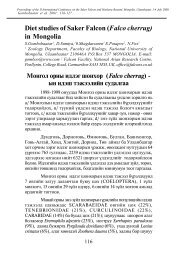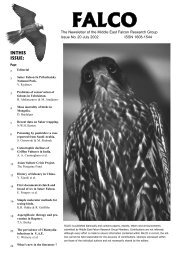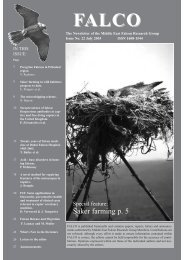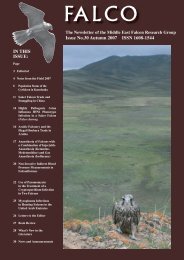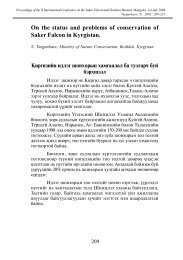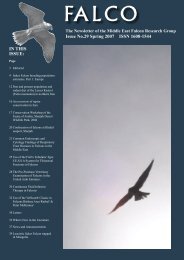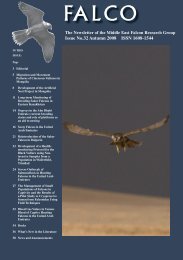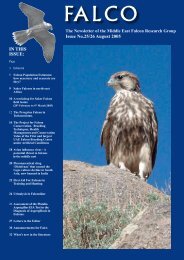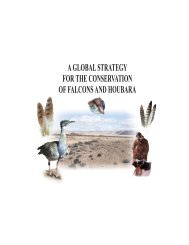Falco 27 - International Wildlife Consultants Ltd.
Falco 27 - International Wildlife Consultants Ltd.
Falco 27 - International Wildlife Consultants Ltd.
- No tags were found...
Create successful ePaper yourself
Turn your PDF publications into a flip-book with our unique Google optimized e-Paper software.
• Inclusion of some Saker <strong>Falco</strong>n breeding sites intoa network of protected areas such as Nature Parks,Nature Reserves, Important Bird Areas (IBA’s) andthe Natura 2000 network of sites.• Activities undertaken by BPPS, BSPB, the policeand Ministry of Environment and Water (MoEW)targeted at preventing nest robbery and trapping.• The current Hunting Law in Bulgaria forbidshunting with Saker <strong>Falco</strong>ns and other birds of prey.Despite of the presence of these national laws and theimplementation of the specific actions detailed above,the population decline has not been reversed and thecurrently the population is close to extinction in thecountry.Ecology of the Saker <strong>Falco</strong>n in BulgariaThe ecology of the species in Bulgaria is not studiedwell and to date no specific ecological study has beenundertaken in the country. Data on the species hasobtained incidentally through other projects and fieldactivities; consequently the available data is scarce andnon-systematic.Figure 2. Saker <strong>Falco</strong>n distribution range in Bulgaria(reproduced from Stoyanov & Kouzmanov 1998). Thebreeding sites are shown in 25x25 km squares. Large dots= Proven breeding, medium dots = Probable breeding andsmall dots = Possible breeding.Breeding distributionIn the past the Saker <strong>Falco</strong>n was regarded as awidespread and very common species over the entireBulgarian territory (especially the northern regionsand the plains around Danube River). In more recenttimes (15-20 years ago) it was still widespread but withdiminished numbers. Nowadays it has a fragmenteddistribution range and has already disappeared frommost of its traditional breeding sites (Domuschiev et al.2005). Stoyanov and Kouzmanov (1998) have preparedthe most recent and complete map of the Saker <strong>Falco</strong>ndistribution range in Bulgaria (reproduced in Figure 2).It must be noted that this map presents the historicaldistribution of the Saker <strong>Falco</strong>n since the early 20 thCentury and has been compiled from published datasince 1918, and not simply from the recent publisheddata of Bulgarian ornithologists and the personal dataof the authors. Consequently, some of the breedingareas shown on this map were no longer extant whenit was compiled in 1998. The breeding distributionof the Saker <strong>Falco</strong>n in Bulgaria is thought by manyresearchers to be closely related to the distribution ofits main prey, the European Souslik.Altitudinal distributionIn the past the species was more numerous in the lowerpart of the country (within the altitudinal range 0 to 500m). Unfortunately this also is the region with greatesthuman presence and anthropogenic pressure. Saker<strong>Falco</strong>ns have largely disappeared from these regionsand most of the recent breeding records relate to highmountains or inaccessible rocky places with low levelsof human disturbance (Figures 3 and 4).Habitat selectionSaker <strong>Falco</strong>ns nest in trees or on rocks close to twomain types habitat in Bulgaria: (i) wetlands such asrivers, bogs, marshes, swamps, fens, peat lands and(ii) open areas such as grasslands or agricultural fields.Michev and Petrov (1985) found 13 Saker nests, nine(69%) of which were on rocks and four (31%) were intrees. Stoyanov and Kouzmanov (1998) found 15 nests,11 (73%) of which were on rocks and four (<strong>27</strong>%) werein trees. According to them nesting on electric pylons ispossible recently. Outside the breeding season, all typesof habitats are used during migration and wintering.DietThe European Souslik is the main prey species takenby Saker <strong>Falco</strong>ns during the nestling period of thebreeding cycle. Nevertheless, Saker <strong>Falco</strong>ns alsofeed on other small mammals (rodents) and small tomedium sized birds such as pigeons, crows and smallpasserines. However, a detailed study on the diet of theSaker <strong>Falco</strong>n has never been conducted in Bulgaria.Breeding biologyThe Saker <strong>Falco</strong>n occupies its breeding territory at theend of February and beginning of March (Domuschievet al. 2005). For regions lower than 1000 m abovesea level it lays eggs in the middle of March and thechicks fledge from the nest at the end of June. Ataltitudes above 1000 m, Saker <strong>Falco</strong>ns lay their eggsat end of March and the chicks fledge in late Juneor early July (Stoyanov & Kouzmanov, 1998). Thetypical incubation period is ca. 30 days, with clutchsizes ranging from 2-6 eggs (normally 3-5). The chicksleave the nest after ca. 40-45 days (Domuschiev etal., 2005). The breeding success of Bulgarian pairsis very low; usually eggs are laid and incubation isobserved but later the nest is abandoned although theadult birds remain in the area. In majority of the casesthe failure is caused by human intervention (Stoyanov



